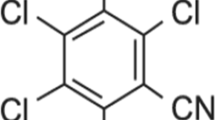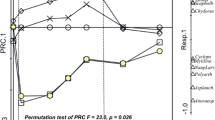Abstract
Natural plankton communities from a tropical freshwater reservoir (Combani Reservoir, Mayotte Island, Mozambique Channel) were exposed, in 20-l nutrient-enriched microcosms, to two nominal concentrations of three pesticides: the herbicides diuron (2.2 and 11 μg/l) and paraquat (10 and 40.5 μg/l) and the insecticide fenitrothion (10 and 100 μg/l), commonly used in the tropics for agriculture and disease vector control. Bacterioplankton, phytoplankton, and zooplankton communities were monitored for 5 days after exposure, and the concentrations of toxicant and major nutrients were measured. Bacterioplankton growth was noticeable in all systems and was slightly affected by pesticide at any concentration. A transitory increase in thymidine-based bacterial production was observed in diuron- and fenitrothion-treated microcosms, followed by a marked decrease in all microcosms after 5 days. The functional diversity of bacterioplankton, evaluated using BIOLOG ECO® microplates, was reduced by exposure to the highest pesticide concentrations. Phytoplankton was affected by pesticides in different ways. Chlorophyll biomass and biovolumes were increased by diuron addition and decreased by paraquat, whereas fenitrothion-treated microcosms remained unaffected relative to controls. Phytoplankton taxonomic diversity was decreased by paraquat and high doses of fenitrothion but was unaffected by addition of diuron. The decrease in diversity was due to a reduction in the number of species, whereas the density of small cells increased, especially after addition of paraquat. Heterotrophic flagellates were sensitive to paraquat and to the highest diuron concentration; a reduction in biomass of up to 90% was observed for 40.5 μg/l paraquat. Zooplankton, dominated by Thermocyclops decipiens and Diaphanosoma excisum, was slightly sensitive to diuron, and very sensitive to paraquat. High concentrations of the insecticide fenitrothion were effective only on young stages. The potential direct and indirect effects of pesticide contamination on such a simplified plankton food web, typical of newly constructed reservoirs, appear to differ significantly depending on the biological compartment considered. The overall sensitivity of tropical plankton is comparable to the sensitivity for temperate systems, and direct and indirect effects appeared rapidly, within 5 days of exposure.








Similar content being viewed by others
References
Barrantes G, Sandoval L (2009) Conceptual and statistical problems associated with the use of diversity indices in ecology. Int J Trop Biol 57:451–460
Bérard A, Leboulanger C, Pelte T (1999) Tolerance of Oscillatoria limnetica Lemmermann to atrazine in natural phytoplankton populations and in pure culture: influence of season and temperature. Arch Environ Contam Toxicol 37:472–479
Blaise C, Férard JF (2005) Small-scale freshwater toxicity investigations. Vol. 1—Toxicity test methods. Springer, Dordrecht, 551 pp
Brandt KK, Jørgensen NOG, Nielsen TH, Winding A (2004) Microbial community-level toxicity of linear alkylbenzene sulfonates in aquatic microcosms. FEMS Microbiol Ecol 49:229–242
Caquet T, Lagadic L, Sheffield S (2000) Mesocosms in ecotoxicology: outdoor aquatic systems. Rev Environ Contam Toxicol 165:1–38
Cetin AK, Mert N (2005) The effects of paraquat on population growth of Scenedesmus acutus. Fresenius Environ Bull 14:634–636
Chapman PM, McDonald BG, Kickham PE, McKinnon S (2006) Global geographic differences in marine metals toxicity. Mar Poll Bull 52:1081–1084
Choi JH, Roche H, Caquet T (2001) Hypoxia, hyperoxia, and exposure to potassium dichromate or fenitrothion alter the energy metabolism in Chironomus riparius MG. (Diptera: Chironomidae) larvae. Comp Biochem Physiol C Toxicol Pharmacol 130:11–17
Daam MA, Van den Brink PJ (2010) Implication of differences between temperate and tropical freshwater ecosystems for the ecological risk assessment of pesticides. Ecotoxicology 19:24–37
Daam MA, Rodrigues AMF, Van den Brink PJ, Nogueira AJA (2009) Ecological effects of the herbicide linuron in tropical freshwater microcosms. Ecotox Environ Safety 72:410–423
Daam MA, Satapornvanit K, Van den Brink PJ, Nogueira AJA (2010) Direct and indirect effects of the fungicide carbendazim in tropical freshwater microcosms. Arch Environ Contam Toxicol 58:315–324
Drake JA, Huxel GR, Hewitt CL (1996) Microcosms as models for generating and testing community theory. Ecology 77:670–677
Freitas EC, Rocha O (2010) Acute toxicity tests with the tropical cladoceran Pseudosida ramose: the importance of using native species as tests organisms. Arch Environ Contam Toxicol (in press). doi:10.1007/s00244-010-9541-2
Garland JL, Mills AL (1991) Classification and characterization of heterotrophic microbial communities on the basis of patterns of community-level sole-carbon-source utilization. Appl Environ Microbiol 57:2351–2359
Hammer Ø, Harper DAT, Ryan PD (2001) PAST: Paleontological statistics software package for education and data analysis. Palaeontologia Electronica 4:9
Hashizume K, Nozawa M, Toda C, Yasui T, Nagano H (1994) Degradability of chemicals by microorganisms in pond water. Jap J Toxicol Environ Health 40:78–90
Haylamicheal ID, Dalvie MA (2009) Disposal of obsolete pesticides, the case of Ethiopia. Environ Int 35:667–673
Hillebrand H, Dürselen CD, Kirschtel D, Zohary T, Pollingher U (1999) Biovolume calculation for pelagic and benthic microalgae. J Phycol 35:403–424
Holmes RM, Aminot A, Kérouel R, Hooker BA, Peterson BJ (1999) A simple and precise method for measuring ammonium in marine and freshwater ecosystems. Can J Fish Aquat Sci 56:1801–1808
Jana DD, Pal GP (1984) The life history parameters of Diaphanosoma excisum (Cladocera), grown in different culturing media. Hydrobiologia 118:205–212
Kashiwada S, Mochida K, Ozoe Y, Nakamura T (1998) Metabolism of fenitrothion in several brackish and marine zooplankton species. J Pest Sci Jpn 23:308–311
Kaur K, Ansal MD (1996) Sensitivity of selected zooplankton exposed to phosphamidon, fenitrothion, and fenthion. Bull Environ Contam Toxicol 57:199–203
Kent RA, Weinberger P (1991) Multibiological-level responses of freshwater phytoplankton to pesticide stress. Environ Toxicol Chem 10:209–216
Knapp CW, Caquet T, Hanson ML, Lagadic L, Graham DW (2005) Response of water column microbial communities to sudden exposure to deltamethrin in aquatic mesocosms. FEMS Microbiol Ecol 54:157–165
Knauer K, Leimgruber A, Hommen U, Knauert S (2010) Co-tolerance of phytoplankton communities to photosynthesis II inhibitors. Aquatic Toxicol 96:256–263
Kwok KWH, Leung KMY, Lui GSG, Chu VKH, Lam PKS, Morritt D, Maltby L, Brock TCM, Van den Brink PJ, Warne MJ, Crane M (2007) Comparison of tropical and temperate freshwater animal species’ acute sensitivities to chemicals: implication for deriving safe extrapolation factors. Integr Environ Assess Manag 3:49–67
Lacher TE, Goldstein MI (1997) Tropical ecotoxicology: status and needs. Environ Ecotox Chem 16:100–111
Lahr J, Diallo AO, Gadji B, Diouf PS, Bedaux JJM, Badji A, Ndour KB, Andreasen JE, van Straalen NM (2000) Ecological effects of experimental insecticide applications on invertebrates in Sahelian temporary ponds. Environ Toxicol Chem 19:1278–1289
Leboulanger C, Dorigo U, Jacquet S, Le Berre B, Paolini G, Humbert JF (2002) Application of a submersible spectrofluorometer for rapid monitoring of cyanobacterial blooms: a case study. Aquat Microb Ecol 30:83–89
Leboulanger C, Bouvy M, Pagano M, Dufour RA, Got P, Cecchi P (2009) Responses of planktonic microorganisms from tropical reservoirs to paraquat and deltamethrin exposure. Arch Environ Contam Toxicol 56:39–51
Lünd JW, Kipling C, Le Cren ED (1958) Inverted microscope method estimating algal number and statistical basis estimations by counting. Hydrobiologia 11:143–170
Matsushita T, Matsui Y, Taniwaki S, Inoue T (2002) Changes in mutagenicity during biodegradation of fenitrothion. Chemosphere 47:9–14
Murphy J, Riley JP (1962) A modified single solution method for the determination of phosphate in natural waters. Anal Chim Acta 27:31–36
Nishihara T, Hasebe S, Nishikawa J, Kondo M (1997) Biodegradation of aniline, anthracene, chlornitrophen, fenitrothion and linear alkylbenzene sulphonate in pond water. J Appl Microbiol 82:441–447
Nyström B, Becker-van Slooten K, Bérard A, Grandjean D, Druart JC, Leboulanger C (2002) Toxic effects of Irgarol 1051 on phytoplankton and macrophytes in Lake Geneva. Water Res 36:2020–2028
Paerl HW, Dyble J, Moisander PH, Noble RT, Pielher MF, Pinckney JL, Steppe TF, Twomey L, Valdes LM (2003) Microbial indicators of aquatic ecosystem change: current applications to eutrophication studies. FEMS Microbiol Ecol 46:233–246
Pagano M, Saint-Jean L, Arfi R, Bouvy M, Shep H (2000) Population growth capacities and regulatory factors in monospecific cultures of the cladocerans Moina micrura and Diaphanosoma excisum and the copepod Thermocyclops decipiens from Côte d’Ivoire (West Africa). Aquat Living Res 13:163–172
Perschbacher PW, Ludwig GM (2004) Effects of diuron and other aerially applied cotton herbicides and defoliants on the plankton communities of aquaculture ponds. Aquaculture 233:197–203
Pesce S, Fajon C, Bardot C, Bonnemoy F, Portelli C, Bohatier J (2006) Effects of the phenylurea herbicide diuron on natural riverine microbial communities in a experimental study. Aquatic Toxicol 78:303–314
Relyea RA (2005) The impact of insecticides and herbicides on the biodiversity and productivity of aquatic communities. Ecol Appl 15:618–627
Sabater C, Carrasco R (2001) Effects of the organophosphorus insecticide fenitrothion on growth in five freshwater species of phytoplankton. Environ Toxicol 16:314–320
Schrader KK, Nanayakkara NPD, Tucker CS, Rimando AM, Ganzera M, Schaneberg BT (2003) Novel derivative of 9,10-anthraquinone are selective algicides against the musty-odor cyanobacterium Oscillatoria perornata. Appl Environ Microbiol 69:5319–5327
Schwarzenbach RP, Escher BI, Fenner K, Hofstetter TB, Johnson CA, von Gunten U, Wehrli B (2006) The challenge of micropollutants in aquatic systems. Science 313:1072–1077
Seguin F, Le Bihan F, Leboulanger C, Bérard A (2002) A risk assessment of pollution: induction of atrazine tolerance in phytoplankton communities in freshwater outdoor mesocosms, using chlorophyll fluorescence as endpoint. Water Res 36:3227–3236
Strickland JDH, Parsons TR (1968) Pigment analysis—a practical handbook of seawater analysis. Bull Fish Res Board Canada 167:185–205
Strickland JDH, Parsons TR (1972) A practical handbook of sea-water analysis. J Fish Res Bd Canada 167:311 pp
Tadonléké RD, Le Berre B, Perreau F, Humbert JF (2009) Responses of lake bacterioplankton activities and composition to the herbicide diuron. Aquat Toxicol 94:103–113
Wiktelius S, Chiverton PA, Meguenni H, Bennaceur M, Ghezal F, Umeh EDN, Egwuatu RI, Minja E, Makusi R, Tukahirwa E, Tinzaara W, Deedat Y (1999) Effects of insecticides on non-target organisms in African agroecosystems: a case for establishing regional testing programmes. Agric Ecosyst Environ 75:121–131
Wong PK (2000) Effects of 2,4-D, glyphosate and paraquat on growth, photosynthesis and chlorophyll a synthesis of Scenedesmus quadricauda Berb. 614. Chemosphere 41:177–182
Zimba PV, Tucker CS, Mischke CC, Grimm CC (2002) Short-term effect of diuron on catfish pond ecology. North Am J Aquac 64:16–23
Acknowledgments
This paper is a contribution to the ECOMET project, funded by the French Ministry of Ecology, Energy, Sustainable Development, and Sea (MEEDDM), grant no. CV070000783. The authors would like to thank the Forestry and Agriculture Office at Mamoudzou (DAF Mayotte) and SOGEA-Mayotte for their help with fieldwork. We are grateful to the staff of the Gîte du Mont Combani for their support during our stay. Anonymous referees are acknowledged for improvement of an earlier version of the manuscript.
Author information
Authors and Affiliations
Corresponding author
Rights and permissions
About this article
Cite this article
Leboulanger, C., Bouvy, M., Carré, C. et al. Comparison of the Effects of Two Herbicides and an Insecticide on Tropical Freshwater Plankton in Microcosms. Arch Environ Contam Toxicol 61, 599–613 (2011). https://doi.org/10.1007/s00244-011-9653-3
Received:
Accepted:
Published:
Issue Date:
DOI: https://doi.org/10.1007/s00244-011-9653-3




